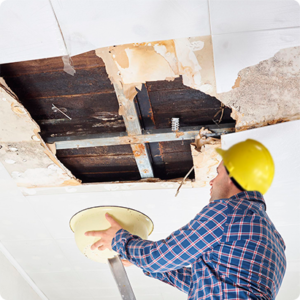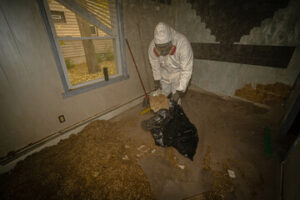A damaged ceiling shouldn’t be left unattended. Cracks and holes are unsightly but can usually be fixed with drywall patching and paint. Water damage is more complicated. It can be expensive and requires proper drying to ensure drywall doesn’t become a source of mold months down the road.
Ceiling cracks accompanied by sagging indicate a potential structural problem that needs to be addressed immediately. Water stains are also not a good sign. Contact Ceiling Repair Perth now!

While drywall cracks are a common issue, the good news is they sometimes mean your house is structurally unsound. However, the nature of ceiling cracks depends on various factors, including their severity, how they appear, and where they occur. In most cases, these harmless, non-structural cracks are cosmetic issues and can be fixed with a simple paint job or plaster repair.
One type of crack that can be a serious problem is long horizontal lines that run across the ceiling. These usually indicate a major shift in the foundation, and can cause doors to stick, windows to open and close, and even create a gap between walls. In these cases, it’s crucial to get a professional assessment as soon as possible to ensure that your home is safe and secure for years to come.
Other types of cracks in the ceiling include spiderweb and hairline cracks. These are often caused by changes in temperature and humidity that cause the wood to expand or contract. This is especially common in homes that have undergone significant renovations that were done without proper planning or consideration of the structural integrity of the house.
Cracks that are accompanied by sagging or other signs of a serious problem in the house may be due to a truss uplift, which can be quite dangerous if it happens near a load-bearing wall. This is also a reason why it’s important to have your home regularly checked by a professional contractor to ensure the structural integrity of your home.
The first thing to do when repairing ceiling cracks is to lay down a tarp or sheet of plastic to catch any mud and debris that may fall. It’s also a good idea to remove any furniture from the room so you don’t have to worry about cleaning it afterward. Finally, set up a ladder that is tall enough to allow you to reach the cracks easily. Then, apply a thin layer of joint compound to the cracks using a trowel and let it dry overnight. Then, apply a second coat and repeat the process if necessary until the cracks are completely repaired.
Water Damage
Water damage in a ceiling is not just unsightly; it can lead to mold and rot, which threaten structural integrity and pose health risks. The first step in repairing water damage to a ceiling is to locate the source. You may be able to identify it by following the sound of dripping or by locating water stains, but in many cases, you will need to call in a professional to help determine where the water is coming from and to prevent more extensive damage.
Once you find the source of the leak, it’s time to contain the water. You will need to place buckets and tarps beneath the leaky area of your ceiling. This will prevent further water damage and keep your belongings safe from water spillage. It’s also important to shut off electricity in the affected area to avoid potential electrical hazards.
After containing the leak and protecting your belongings, you can begin the repair process. This may involve removing and replacing the damaged section of the ceiling, or it might simply mean filling in a few small holes with drywall mud and painting. If the damaged area of your ceiling is large, you might want to consider hiring a professional to replace the entire section.
It’s important to dry out the area before completing repairs, as moisture can cause further damage to drywall and other building materials. It’s also important to clean any areas that have been saturated with water to prevent mold and bacterial growth.
While it might be tempting to skip the cleaning and painting, this will only prolong the life of your ceiling and make the job more difficult in the long run. By taking the time to thoroughly clean and dry the affected area, you can ensure that your ceiling repair is a success.
A professional can help you restore your ceiling to its original condition and provide the best possible safety and functionality for your home or business. Contact a local ceiling repair company to learn more about the services they offer and to schedule an appointment.
Sagging
A sagging ceiling can be dangerous and require immediate repair. It can collapse and fall and damage your home’s contents, structure and lead to water damage, mold, mildew and other health risks.
Unlike cracks in walls or slabs, a sagging ceiling is usually a structural issue that needs to be repaired immediately. A professional building inspector will be able to assess the problem and determine what repairs are required. This may involve reinforcing the joists or a complete replacement of the ceiling.
Many different factors can cause a sagging ceiling, but it’s important to identify the root cause before attempting any repairs. It is also important to make sure that you have a first-aid kit available and someone to call in case of an emergency during the repair process. It’s also advisable to turn off your electricity and water before beginning the repair process to minimize the risk of injury.
Sagging is most often caused by shifting in the foundation or changes in temperature that cause the structure of a house to move, expand and contract. This can cause plasterboard, cornices and other building materials to warp and stretch. This can be caused by poor construction or insufficient support from wall and beams.
Roof leaks can also cause sagging in ceilings as water seeps into insulation and adds weight to the plasterboard. This can lead to moisture damage, mould and mildew which in turn adds even more weight to the ceiling.
Other causes of sagging in ceilings include ageing, and the wearing out of fixings and adhesives. This is particularly common in older homes. In some cases, this can be remedied by replacing the existing adhesives and fixings.
Identifying the root cause of your sagging ceiling is essential for a long-term fix. This can be a complicated job and should only be carried out by professionals. It’s important to find the right contractor for your needs. They should have a range of experience in repairing and renovating residential and commercial properties. They should be able to provide an accurate diagnosis and carry out the necessary repairs with precision and efficiency.
Mold
Mold growth on ceilings is more than just unsightly, it can be a serious health hazard. It can cause breathing problems for people with allergies or sensitive skin. Mould can also damage the material on which it grows. Mold growth in a home should be dealt with promptly to protect the health of everyone in the house.
The problem is most often caused by a combination of poor ventilation and missing insulation. These create cold spots where the ceiling meets the walls, leading to condensation that eventually leads to mold. If you are unsure whether the mold in your ceiling is due to condensation or smoke, try running a moisture meter over the area. Moisture from condensation will typically not register on a meter, but smoke residue will.
To remove the mold, first, prepare a cleaning solution made of one part bleach to three parts water in a spray bottle. Alternatively, white vinegar can be used, which is less harsh and more eco-friendly. Then, apply the solution to the affected areas of your ceiling and allow it to sit for a few minutes so that it can kill the mold spores. Scrub the area with a scrub brush or sponge, being careful not to scratch or damage the surface of your ceiling. After scrubbing, rinse the ceiling thoroughly with clean water to remove any remaining cleaning solution or mold particles. Finally, dry the ceiling with fans and dehumidifiers to prevent further mold growth.
While these methods will remove the existing mold, they won’t keep it from coming back unless you address the source of the moisture. To do this, you’ll need to make sure that your house has good air flow, use a fan when showering or bathing, and don’t leave damp towels hanging on the wall.
The best way to prevent future mold growth is to fix any leaks in your roof as soon as possible and to install effective insulation. Also, make sure to regularly wash your ceiling with a detergent solution mixed with a few tablespoons of baking soda.
